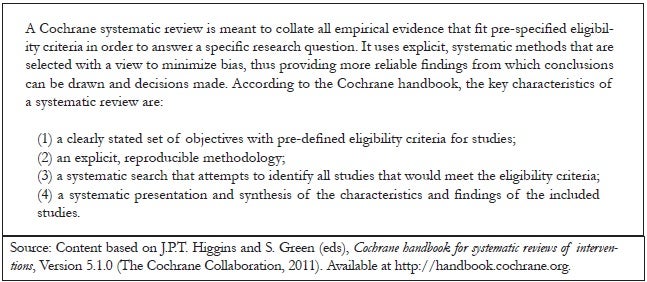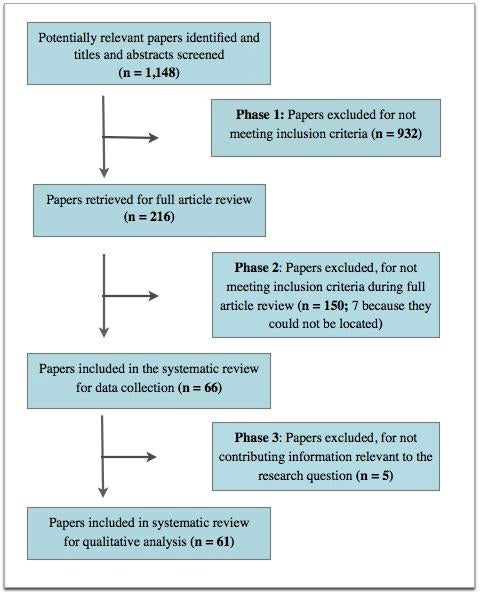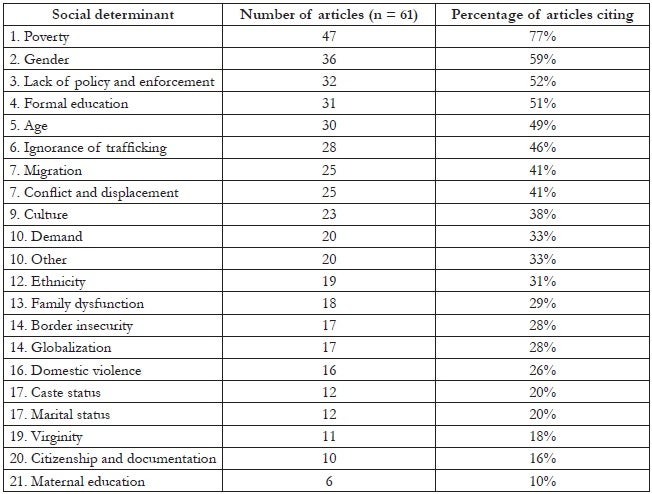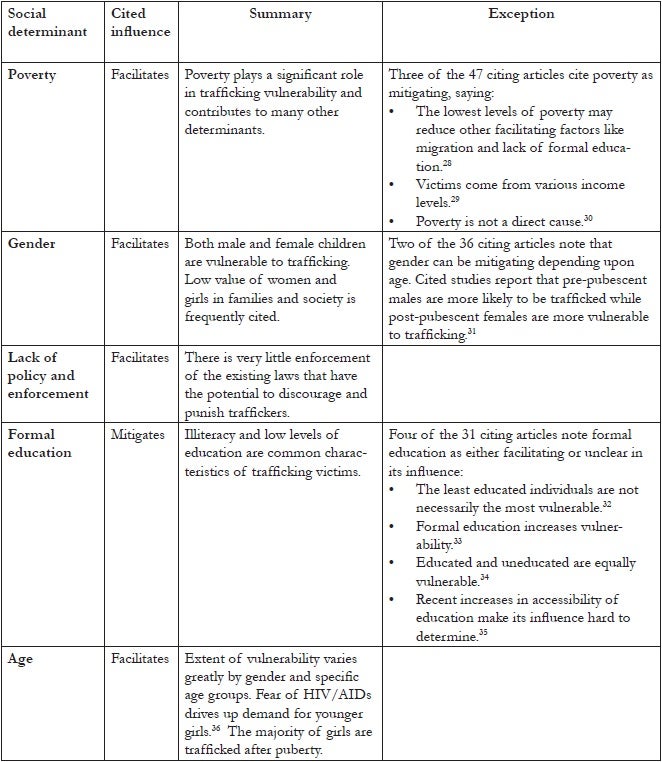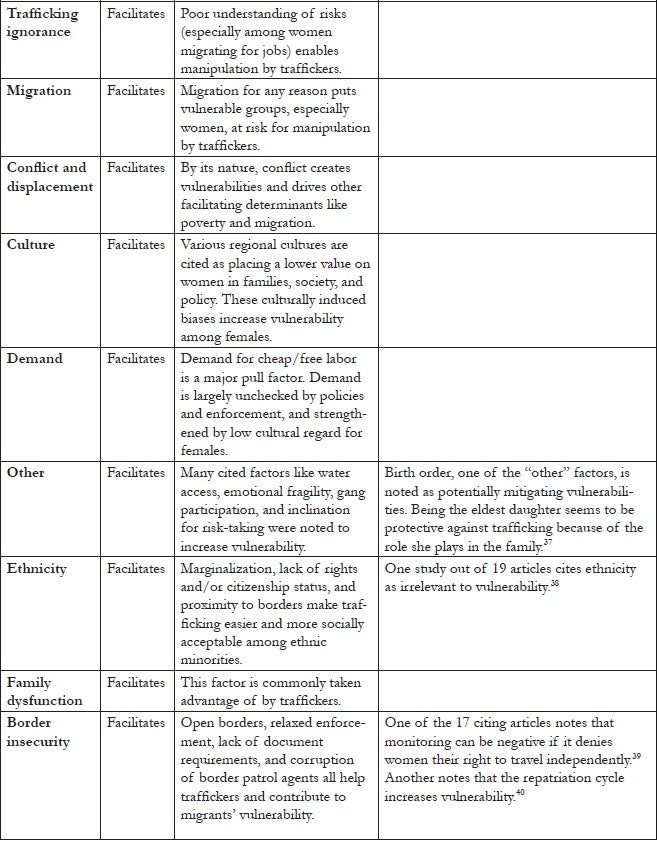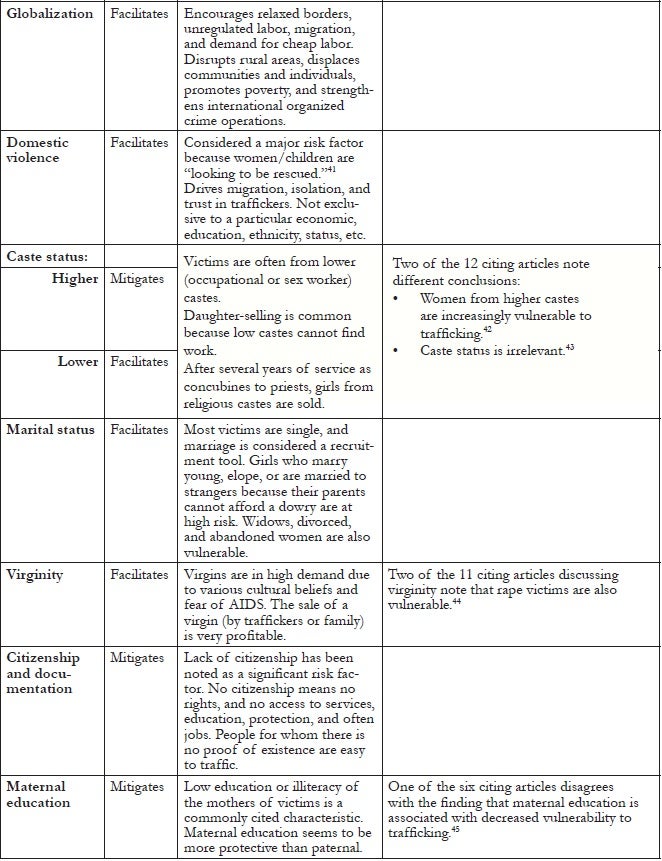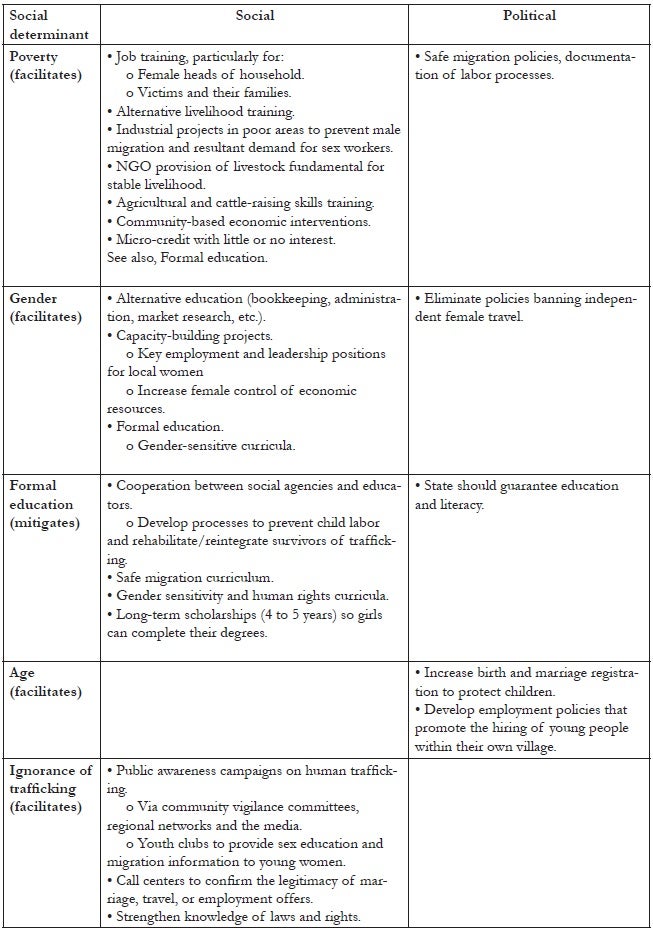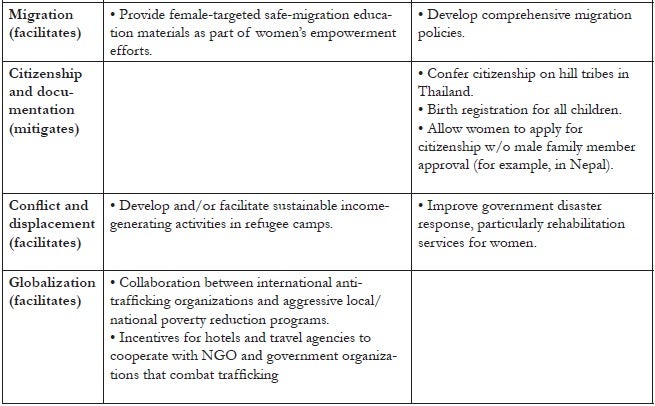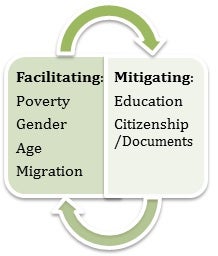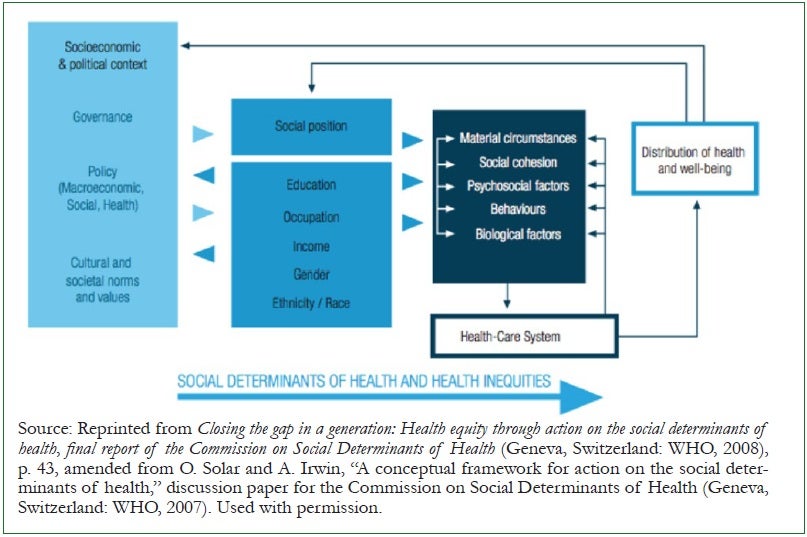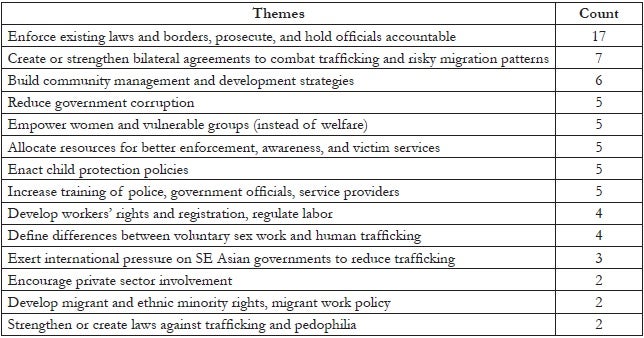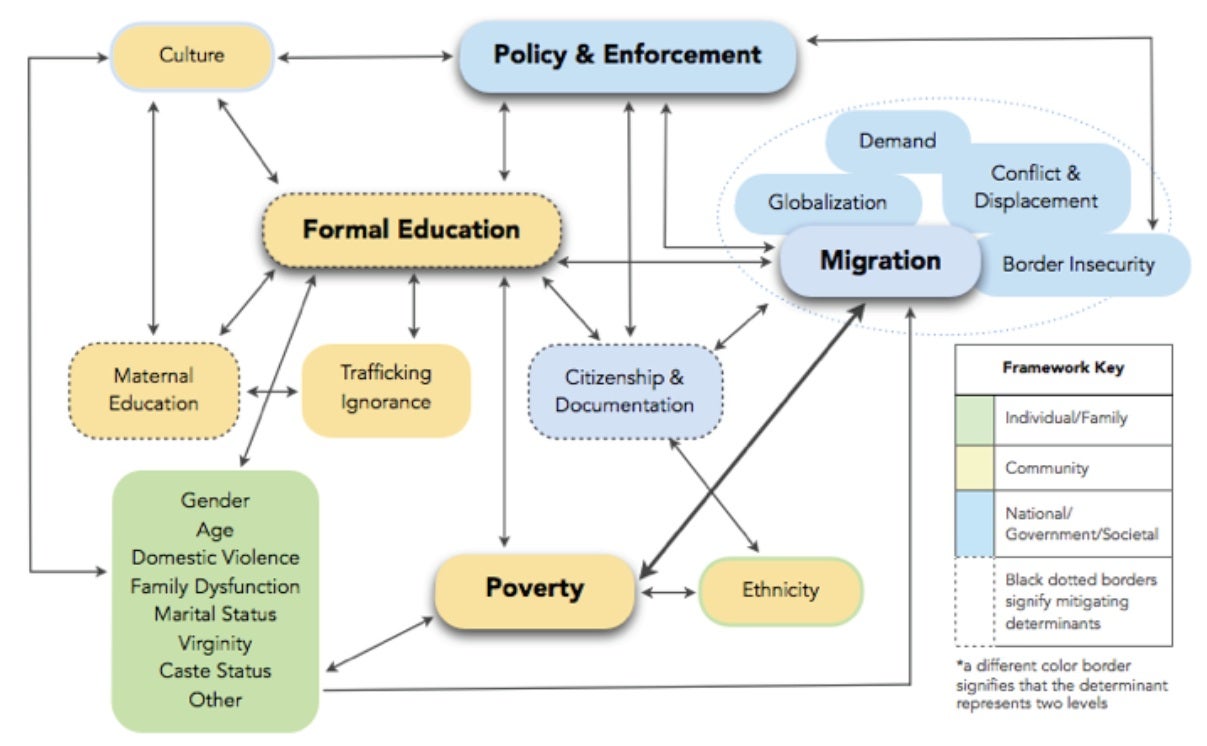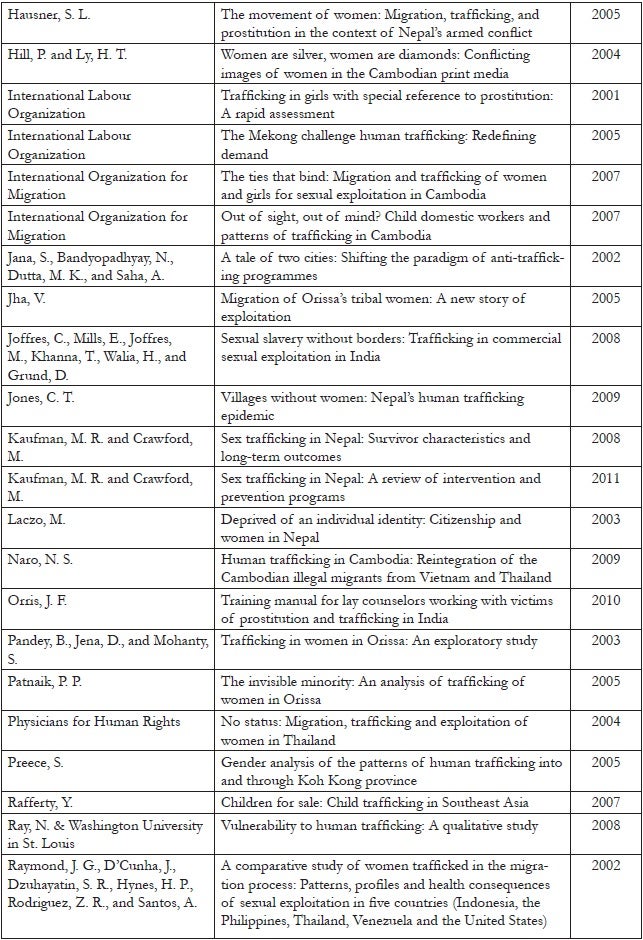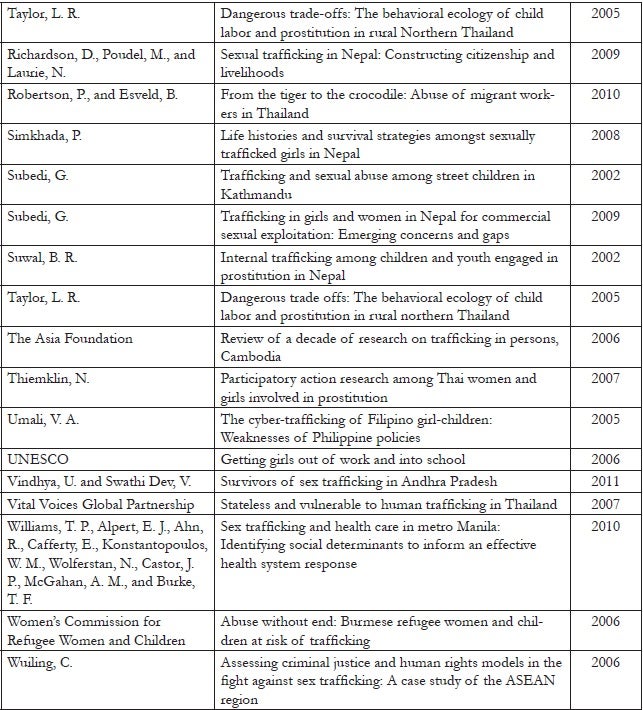Kelsey McGregor Perry and Lindsay McEwing
Health and Human Rights 15/2
Published December 2013
Abstract
Background: The sale of women and children accounts for the greatest proportion of human trafficking globally, with Southeast Asia acting as the illegal industry’s largest international hub. At least 225,000 women and children are trafficked from the region every year, accounting for approximately one-third of the global human trade. The health ramifications of trafficking are severe: many survivors contract infectious diseases including sexually transmitted infections and develop mental health conditions, including anxiety, panic disorder, and major depression. The complications associated with studying a highly secretive illegal trade have severely limited research on effective prevention measures. Because this presents a challenge for organizations that hope to develop prevention strategies, we asked the following question: How do social determinants facilitate or mitigate trafficking of women and children in Southeast Asia, and what recommendations does the literature provide for combating trafficking via these social determinants?
Methods: Using a Cochrane-based systematic search methodology, five independent researchers reviewed 1,148 articles from the past ten years (2001–2011). After three phases of independent review, they selected and analyzed 61 articles to identify the determinants that impact trafficking of women and children in Southeast Asia.
Results: Key social determinants that facilitate trafficking include poverty, female gender, lack of policy and enforcement, age, migration, displacement and conflict, ethnicity, culture, ignorance of trafficking methods, and caste status. Conversely, protective determinants that mitigate trafficking include formal education, citizenship, maternal education, higher caste status, and birth order. Recommendations relating to a variety of the determinants are identified and discussed in detail.
Conclusions: Social determinants are central to the processes that mitigate and facilitate the sale and exploitation of women and children in Southeast Asia. Specifically, the facilitation of education and empowerment, along with the creation and enforcement of effective policies, could lessen the vulnerability of women and children to modern-day slavery.
Introduction
The booming global business of human trafficking, currently the second largest source of illegal income worldwide, is driven by a concerning blend of social circumstances.1 These circumstances, called social determinants, are the social, economic, political, and environmental conditions that shape how people live, grow, and work. They ultimately affect people’s vulnerability to exploitation.2 Profit-driven criminal groups thrive on unfavorable determinants like poverty and joblessness when they traffic 700,000 to 2 million people annually.3
One source places the estimate of children trafficked globally every year as high as 1 million—with the total number of children in forced prostitution reaching as high as 10 million.4 The trafficking of children has been called “a global phenomenon connecting all countries and regions of the world in a complex network of illicit movement.”5 Indeed, the UN Office on Drugs and Crime (UNODC) estimates that 75% of trafficking victims are women and children.6 Adult females make up 55% to 60% of all trafficked victims globally, followed by girls at 17%.7 Disturbingly, the UNODC’s 2007–2010 estimates reveal a rise in the total percentage of child victims from 20% to 27%.8
This exploitation of women and children easily accounts for the greatest proportion of global human slavery. Consequently, women and children bear the brunt of countless negative health outcomes, both physical and mental. In a study of women trafficked to the European Union, researchers determined that 95% of victims had been “violently assaulted or coerced into a sexual act,” and over 60% of victims reported “fatigue, neurological symptoms, back pain, vaginal discharges, and gynecological infections.”9 Women and girls are particularly vulnerable to reproductive and other gender-specific health problems because they have little or no access to reproductive healthcare. These problems can include “lack of access to birth control, constant rapes, forced abortions and contraceptive use, lack of regular mammograms and Pap smears, and other health issues.”10 Female trafficking victims in domestic servitude are frequently subjected to rape and other physical abuse, while trafficking victims in forced prostitution suffer increased risk of sexually transmitted infections, including HIV/AIDS; repetitive stress injuries; and back problems.11 There are many additional physical health consequences related to trafficking, including cervical cancer.12
In addition to various negative physical outcomes, researchers report that survivors of trafficking frequently suffer from multiple layers of trauma including “psychological damage from captivity and fear of reprisals if escape is contemplated, [and] brainwashing.”13 Survivors may also suffer from anxiety, panic disorder, major depression, intense feelings of shame, substance abuse, and eating disorders. Many survivors also suffer from post-traumatic stress disorder (PTSD), including the following symptoms: intrusive re-experiencing of trauma (such as flashbacks and nightmares); avoidance or numbing of trauma-related or trauma-triggering, stimuli; and hyper-arousal (heightened startle response and inability to concentrate).14 For both adults and children, PTSD is typically chronic and debilitating when left untreated.15
Though human trafficking is a phenomenon that permeates every region of the world, Southeast Asia is well recognized as its greatest hub. It has been conservatively estimated that at least 225,000 women and children from the region are trafficked every year, accounting for approximately one-third of the global trafficking trade.16 Approximately 60% of trafficking victims in Southeast Asia are directed toward major regional cities, while the remaining 40% are trafficked to various locations across the globe.17 Approximately 60% of the 50,000 women and children estimated to be trafficked to the United States are from Southeast Asia, making it the largest regional source in the world for trafficking to the United States.18 Experts suggest that the growth of sex tourism in Southeast Asia is one of the main contributing factors to the disproportionately high rates of trafficking. Traffickers are encouraged by “large tax-free profits and [continuous] income from the same victims at very low risk.”19 A 1998 survey of Southeast Asia by the International Labour Organization found that sex industries in the region accounted for 2% to 14% of the GDP.20
Because trafficking is so difficult to identify and prosecute, research on related social factors and effective prevention measures has been severely limited.21 However, as noted by the UNODC in its 2012 Global Report on Trafficking in Persons, in order to successfully combat human trafficking, “it is essential to understand what makes [victims] vulnerable to violence, abuse and exploitation in the first place.”22 A preliminary literature search in 2011 showed that the Cochrane Library Database of Systematic Reviews had no reviews on trafficking, and in the Campbell Library, only one review was found, which did not address social determinants.23
The lack of systematic compilation of trafficking data presents a challenge for human rights and public health organizations that hope to develop prevention strategies that will eliminate the multitude of health burdens thrust upon victims of trafficking. We performed a comprehensive, systematic review of the literature in an effort to address this absence. This research question guided our review: How do social determinants facilitate or mitigate trafficking of women and children in Southeast Asia, and what recommendations does the literature provide for combating trafficking via these social determinants?
Methods
The research design for the project was a systematic literature review based on the Cochrane approach (see Table 1). Modifications to the Cochrane approach included the emphasis on qualitative data collection and analysis, and the inclusion of English-language articles only.
Criteria for inclusion
Key criteria measures required for the review included a discussion of trafficking of women and children within Southeast Asia and the role of social determinants in relation to the described trafficking. The “trafficking” criteria were defined according to the Protocol to Prevent, Suppress, and Punish Trafficking in Persons (Palermo Protocol), which contains three main elements: (1) the “act” of “recruitment, transportation, transfer, harboring or receipt of persons” through (2) “means” such as the “threat or use of force, coercion, abduction, fraud, deception, abuse of power or vulnerability, or giving payments or benefits” for the (3) “purpose” of “prostitution of others, sexual exploitation, forced labour, slavery or similar practices, removal of organs or other types of exploitation.”24
Table 1. The Cochrane method
As was noted in The Lancet, there is considerable conceptual confusion about the term “trafficking,” which can lead to inappropriate conflation with other migration terms.25 To avoid the conflation of trafficking with other illicit activities, this review includes only articles detailing social determinants relative to the definition of trafficking provided by the Palermo Protocol. Different or additional social determinants may be at play in bonded labor, child labor, child soldier, and devadasi (temple concubine) situations: thus, researchers did not include articles on these subjects which had no reference to the characteristics of trafficking. Researchers did include several articles addressing these forms of exploitive labor, but only after confirming they discussed details that met the definition of trafficking.
While women were identified as females aged 18 and older, and children were defined as individuals under the age of 18, the literature frequently labels victims as women and children without specifying age.26 Therefore, researchers simply considered “women and children” as an acceptable identification. Specific key countries within the Southeast Asia region that bear the greatest burden of trafficking were selected for the review, including Burma, Thailand, Laos, Nepal, Philippines, Cambodia, India, Bangladesh, and Sri Lanka. The criteria of social determinants were defined as the circumstances in which women and children are “born, grow up, live, work and age, and the systems put in place to deal with illness.”27
Finally, all study and intervention types were included in the review. Although randomized controlled trials, quasi-experimental studies, and observational studies were included, the majority of study types were qualitative given the challenges of performing analytical research on human trafficking. In order to minimize publication bias, gray literature (data-driven resources disseminated through noncommercial sources) were also included in the review. Books, editorials, and opinion pieces were excluded.
Data collection
Due to the rapid development of human trafficking, articles from the last ten years (2001–2011) were considered for the review. Data from the last decade are most likely to accurately reflect the changes and relevant challenges of current trafficking methods. The instruments used for data collection included PubMed, EBSCO (including ERIC, CINAHL, PsychINFO, Women’s Studies International, and Social Work Abstracts), and ProQuest (including PAIS International and Social Services Abstracts). These databases were evaluated and recommended by the subject librarians at the Brigham Young University (BYU) Harold B. Lee Library and at the World Health Organization (WHO).
Researchers applied a predetermined search strategy in the described databases in November 2011. Article selection was conducted in three phases: 1) an initial screening of titles and abstracts against the inclusion criteria to identify potentially relevant papers, 2) a screening of the full papers selected in the first phase, and 3) a screening of the included papers against the research question (see Figure 1). Five researchers independently evaluated the search results at each of the three phases of the review. Prior to beginning each phase, researchers met together to discuss the inclusion criteria and independently apply the criteria to five practice articles. Decisions were then discussed to confirm that reviewers were applying the criteria consistently. Next, researchers separated to review the articles independently, and after each completed phase, the group met to confirm their selections and coordinate any discrepancies. Personal bias was controlled by maintaining this process of independent review complemented by unanimous group decision.
Data coding
After the third phase, included articles (n = 66) were divided among the five researchers and relevant data were coded in tables. Next, each researcher independently reviewed the coding decisions of one other researcher. Researchers excluded five additional articles at this phase (n = 61), after determining that those articles did not contribute information relevant to the research question.
Data analysis
Qualitative content analysis was the primary method of data analysis. First, data were analyzed and categorized by determinant. These data included relevant recommendations, policy, intervention, prevention, and rehabilitation measures. The primary researcher then collected counts and ran descriptive statistics.
Figure 1. Schematic diagram of review methods
Results
At the conclusion of the project, a total of 61 included articles and 1,091 quotes containing relevant information and data (hereafter referred to as “data”) were categorized regarding the role of social determinants. Twenty-one key determinant categories were identified and coded, including an “other” category. Themes grouped under “other” were diverse factors that were infrequently cited and which did not fit under any of the key determinants. Additionally, some data were counted in more than one category, such as migration and border insecurity, given their overlapping themes.
Table 2. Identified social determinants and their citation frequency among included articles
Identified determinants were ranked by calculating the number of articles out of the total 61 which discussed each determinant (see Table 2). Among the 21 determinants, some were cited by the same number of articles, and therefore received the same numerical ranking.
It should be noted that the literature does not always discuss these determinants in the same context; while many articles agree, for example, that poverty is a social determinant that makes women and children vulnerable to trafficking, there are articles that digress from this norm. Therefore, the fact that a social determinant appears in the literature consistently does not necessarily mean that it is always characterized in the same way. Any such inconsistencies are noted in Table 3.
Mitigating and facilitating factors
Researchers further categorized key determinants as either mitigating or facilitating trafficking, presented in Table 3. Mitigating determinants are those found to offer some measure of protection against trafficking or reduction of vulnerability. Facilitating factors are determinants commonly associated with vulnerability to trafficking, and status as a victim. Exceptions to the general consensus are noted to reflect disagreements in the literature on the influence of certain determinants.
Table 3. Mitigation and facilitation categorizations
Discussion
Health challenges that arise from the sale and exploitation of human beings are fully preventable. These are not naturally arising, uncontrollable conditions; they are orchestrated by an unacceptable blend of social factors that allows vulnerable persons to be abused and enslaved to the point that severe health problems, and often death, result. These outcomes can be prevented by focusing on the social determinants that facilitate human trafficking. Addressing social determinants is a primary approach to achieving health equity, or “the absence of systematic disparities in health between and within social groups that have different levels of underlying social advantages or disadvantages—that is, different positions in a social hierarchy.”46 Here, the identified social determinants serve as an upstream opportunity to prevent and mitigate the trafficking of women and children in Southeast Asia, ultimately fostering greater social equity among stratified communities. Every person, regardless of their socioeconomic status, has the right to live a life free of slavery and abuse. Indeed, human trafficking amounts to a human rights violation because it abrogates so many other fundamental human rights: rights to liberty, security, life, freedom of movement, just and favorable work conditions, health, education, and freedom from slavery and torture, to name a few.47
In an effort to facilitate improved health equity, WHO’s 2008 Commission on Social Determinants of Health identified three key objectives: (1) improve daily living conditions; (2) tackle the inequitable distribution of power, money, and resources; and (3) measure and understand the problem and assess the impact of action.48 We find that the determinants identified in this review are in line with the first two objectives, and stand behind the final objective as an ideal strategy for addressing the identified determinants.
In order to effectively address these social factors, it is critical to understand the relevant recommendations given by experts in the literature. These recommendations will compose the bulk of the discussion and allow us to aid policy makers and practitioners in determining next steps to reduce trafficking vulnerabilities. We note with interest that our identified recommendations tend to be either government-level action or local grassroots interventions. Table 4 organizes the identified, determinant-specific recommendations as either social or political actions (excluding the determinant “lack of policy and enforcement,” which is formatted separately in Table 5). This delineation will aid interested parties in identifying which measures they are best suited to address, while still emphasizing that these recommendations are interconnected, both by and between determinants. For example, two of the poverty-determinant recommendations capture the interplay between social and political actions: (1) improve education that aims to increase job skills (social) and (2) implement effective labor migration policies (political). These recommendations have a clear interdependence: newly educated individuals seeking to migrate for work must be protected by effective migration policies. Thus the two measures should inform each other, even though they are likely to be developed and adopted by different groups.
Further, the recommendations given for different determinants are also related. For example, facilitating-determinant recommendations are directly related to other mitigating determinants, and Figure 2 reflects that feedback cycle. Some of the recommendations for poverty, gender, age, and migration point to the mitigating determinants of education and citizenship/documentation, which in turn are best promoted when framed in light of the related facilitating determinants (such as gender-sensitive curriculum).
Table 4. Summary of social and political recommendations by determinant
As noted earlier, facilitating-determinant recommendations are directly related to other mitigating determinants; Figure 2 illustrates this phenomenon.
Figure 2. Interplay of facilitating and mitigating social determinants
The Commission on Social Determinants of Health developed a framework to illustrate the complex relationships between social and structural determinants of health, emphasizing the importance of addressing both (see Figure 3). The Commission articulated that effective interventions address both the circumstances of daily life (such as social and environmental factors which lead to social stratification) and the structural drivers (such as biases and norms of society, global and local governance).49 Thus, while an understanding of this review’s 21 identified determinants will enable policymakers and communities to better combat trafficking, these factors cannot simply be labeled and targeted independently. Rather, each determinant should be understood both individually and within the broader context of the other social determinants. Only then will prevention measures be effective.
In an effort to thoroughly communicate the recommendations identified in Table 4, certain determinants are discussed in greater detail in the following sections. Naturally, recommendations for each determinant often intersect with recommendations for other determinants. A full discussion of “lack of policy and enforcement” recommendations and a related table follow these sections.
Figure 3. Commission on social determinants of health: Conceptual framework
Poverty
Many articles suggest implementing poverty-reduction techniques, including job training, education, and community-based economic interventions. The literature advises that, due to the many demands on single mothers, economic interventions targeting women in this group should require “a maximum of one year’s training and yet make a difference in [their] wage level.”50 Additionally, the economic empowerment programs and interventions noted in Table 4 have been suggested as the most effective poverty-reduction techniques for vulnerable women.51
While these poverty-reduction recommendations are limited, many experts have written in-depth evaluations of the challenge of poverty. Due to the rigorous requirements of this review, many excellent publications on poverty were not included. However, interested readers can further investigate the literature to identify best-practice poverty-reduction interventions among women and children. Further, additional research identifying whether such techniques are effective in mitigating trafficking would add great value to the findings of this review.
Gender
To reduce gender-related vulnerabilities to trafficking, the literature emphasizes the broad imperatives of expanding female control of economic resources and access to education, along with ameliorating gender discrimination and the low status of the female gender. Specifically, L. R. Taylor cautions against misperceptions about the opportunity costs of educating girls and highlights the importance of community-based capacity-building projects among women and girls. Recommended projects include “bookkeeping, administration, marketing research, or other functions that are often performed by expatriate foreigners or nonlocal Thais but that young villagers are capable of performing well.”52 Taylor posits that programs that utilize girls’ skills and hold them in high esteem would potentially encourage some young women to “stay in the villages while bringing status and income to their families and perhaps becoming community leaders in the process.”53 In addition to these directives, various gender-related recommendations, such as gender-sensitive education and migration policies are incorporated into other determinant sections and are discussed below.
Formal education
Various sources emphasize the importance of joint collaboration between primary education and social protection agencies. UNESCO suggests that this approach would enable educators to help prevent child labor and facilitate rehabilitation and reintegration for child trafficking survivors.54 Additionally, R. J. Raymond, J. D’Cunha, S. R. Dzuhayatin, et al. offer a number of suggestions regarding education as a protective factor against trafficking. First, they emphasize that the state must guarantee literacy via formal and informal education available to all women and girls.55 Further, they encourage the incorporation of gender sensitivity and human rights concerns into school and university curricula and the public dissemination of related material through local and national media.56 Complementary to these suggestions, S. Hausner adds that in addition to formal schools, youth clubs might consider providing sex education and migration information for young and adolescent girls.57 These numerous recommendations, while insightful, would benefit the anti-trafficking community more if best-practice examples were available for reference.
Age
Unfortunately, the recommendations specific to age as a determinant are essentially nonexistent in the literature apart from one recommendation from Asian Development Bank: “increase birth and marriage registration to protect children.”58 However many of the recommendations addressing the determinants of poverty, education, gender, and policy have the potential to also impact the determinant of age, as S. Deb, A. Mukherjee, and B. Mathews suggest:
A high risk for child trafficking and sexual exploitation is created by the proclivity of many adults to exploit children financially and sexually, within this atmosphere of overpopulation, poverty, lowly paid employment, illiteracy, lack of educational opportunities, general lack of promotion of children’s rights, and the limits on children’s life chances through poor education.59
Migration
Because women are particularly vulnerable to trafficking during the search for employment and related migration, the literature suggests conducting campaigns to reduce ignorance of trafficking. Sensitization and awareness campaigns could be introduced through community vigilance committees, regional networks, the media, gainful employment programs, and alternative livelihood training.60 Notably, one included study concludes: “anecdotal evidence from women in villages which were beneficiaries of anti-trafficking programs suggests that awareness-raising campaigns have worked” in the effort to reduce ignorance-related vulnerabilities to trafficking.61 That same study suggests that call centers could be used by girls and women seeking employment to determine the legitimacy of marriage, travel, or employment offers.62 Moreover, given that “the job description [provided] by traffickers is so close to authentic job profiles and salary profiles that it is difficult to disentangle a false offer from a genuine one. … the message should emphasize ‘who’ is offering and not ‘what is being offered’. The ‘what’ angle might fuel resentment in the youth against the adage ‘too good to be true’ but the ‘who’ angle would make them aware.”63 However, Ray also offers this caveat: “While complete lack of awareness about trafficking leads to vulnerability to deception, awareness per se is not a protective factor.”64
Additionally, other recommendations include training individuals to keep records of contact addresses where they can go for help, increasing their knowledge of travel routes and borders, encouraging regular updates to family while traveling, and the carrying of their own funds.65 Anecdotal evidence suggests that memorizing contact information for family, and particularly for local contacts in a destination city, can be useful to vulnerable persons who might find themselves tricked by prospective employers.
The literature also gives policy recommendations, which broadly focus on making processes transparent and understandable for migrants (detailed in the following section). Furthermore, included articles criticize legislation in a number of countries that bar women from migrating alone. These well-intentioned policies, meant to reduce trafficking of women and girls, have instead facilitated it and minimized legitimate migration methods for females. Alternatively, Balaji Pandey suggests the legalization of women’s migration for jobs, “making immigration procedure simpler and more transparent, respecting the human rights of migrants, acknowledging the contributions of migrant women and providing them with just remuneration, and according independent residence status to partners of citizens.”66 Such measures could expand job choices for women, strengthen female migrants’ rights, and reduce the power of brokers and traffickers.67 Indeed, trafficking victims frequently cite the employ of a “broker” to cross borders and arrange work; thus, monitoring of the broker industry could reduce the amount of exploitation during the migration process.
Policy and enforcement
Despite the limited number of recommendations for some key determinants, the literature surrounding “lack of policy and enforcement” (the third most commonly cited determinant) is filled with suggestions. In an effort to capture the diversity and specificity of policy recommendations, subtopics were further analyzed to determine the dominant policy-based recommendations (Table 4). Notably, the most common recommendation mentioned is the need to effectively enforce existing laws that could lead to arrests and prosecutions of traffickers. This is consistent with recommendations from the UNODC’s 2012 Global Report on Trafficking in Persons, which called for increased prosecutions in light of the very low reported conviction rates: among 132 countries, 16% did not record a single conviction between 2007 and 2010.68 One included article aptly notes: “Traffickers’ activities are not difficult to document, yet they carry on. Some traffickers have been arrested and fined by the police but their activities have not stopped. Their profits are shared with police, local community leaders, club members, etc. Clearly, local society alone does not have the proper mechanisms nor the power to stop them. To do so requires a political will and a police force at a higher level.”69
Table 5. Most commonly cited policy-based recommendations
In summary, the major policy recommendations gleaned from the literature include development of regional or bilateral migration policies; implementation of neutral state-level migration departments; incorporation of gender and trafficking issues into policy and education; improved prosecution of traffickers; improved training of border guards, police, and health practitioners; improved investigation of missing persons; and increased numbers of female legislators and police officers. These diverse recommendations combine to offer a holistic view of future steps that can strengthen necessary policy and enforcement relative to trafficking of women and children in the Southeast Asia region. As noted by the Commission on Social Determinants, “Policy coherence is crucial—this means that different government departments’ policies complement rather than contradict each other in relation to the production of health and health equity.”70 This coherence is consistently called for in the literature; civil society and communities must be involved in that holistic process for the success of implemented policy.
Working framework
While some of the identified determinants and their related recommendations are surprising or specific, many seem relatively intuitive. Even a reader without prior exposure to the challenge of human trafficking could probably guess at some of the social factors we identified in our review. Rather than being surprised by the particular social factors we found in the literature, we were instead impressed by the interaction among determinants. The main finding of this review is not any particular social determinant but rather the identification of many determinants and how they interact to facilitate and mitigate trafficking. Leveraging these interactions will be crucial to the success of the anti-trafficking agenda. In an effort to synthesize the identified relationships, we developed an illustrative framework (Figure 4). This framework communicates both the determinant relationships (via arrows) and the societal level of the determinant (via color): individual/family, community, and national/governmental/societal. The framework is meant to capture the social-political interplay suggested in Table 4, while also illustrating the interdependence of determinants captured in Figure 2 and the determinant recommendation discussion. Though broad in its nature, ideally this framework will serve as a resource to anti-trafficking groups—whether at the governmental, community, or individual level—by providing a map of relevant determinants and their societal impacts.
Figure 4. Framework of the relationships among social determinants of trafficking
While collecting and analyzing the review data, it became clear that several determinants integrally inform the broader determinant of migration. Migration as a societal issue is driven by the determinants of demand for labor, globalization, conflict and displacement, border insecurity (all of which influence each other), and the challenge of poverty and joblessness (though not included in the circled cluster, the tie is illustrated by a bold arrow). This comprehensive category is then influenced by many other determinants, including the individual/family level determinants, education, and so forth. While migration makes up just one component of the trafficking picture, it is a considerable factor that facilitates the sale and exploitation of vulnerable people. The literature clearly reveals that in most instances of trafficking, a person migrates in search of work (a decision informed by many determinants, including education level, poverty, age, gender, etc.), accepts a questionable work proposal, and is then sold into a brothel or forced labor factory or camp. While this scenario does not capture every instance of trafficking, it is a story that is told repeatedly. Other determinants such as border insecurity or lack of citizenship or documentation (issues that are particularly common among ethnic groups or persons of lower caste status) exacerbate this situation and the effect of other determinants. When borders are unregulated, traffickers frequently manipulate even legal labor migrants who are then forced across a border that is unmonitored. The Trafficking in Persons Report produced by the US State Department notes, “Aspirations for a better life will continue driving women and men around the world to seek new opportunities. Traffickers will continue seeking zones of impunity where lax regulation and poor oversight make workers vulnerable.”71 Thus, understanding the role of migration as a broader determinant and the factors that facilitate unsafe migration is critical to the anti-trafficking effort.
In addition to migration, three other determinants are crucial; as the framework illustrates formal education, poverty, and policy and enforcement are also key determinants. These four determinants stand out in the literature as particularly influential: as overarching issues, they connect the other identified determinants. Indeed, the presence of other determinants is always tied to at least one of these major factors, creating a web of interconnectedness. Only by recognizing and capitalizing on these connections can we effectively combat the complex challenge of human trafficking.
Limitations
Naturally, the results of this review should be considered within the context of its limitations. First, only articles written in English were included. Though the majority of relevant papers have likely been published in English, it is possible that some might not have been accessible in English. Further, while each of the five reviewers was trained to consistently apply the protocol criteria, it is possible that some reviewers introduced personal biases during the independent reviews. The reviewers thoroughly discussed as a group any selection choices that were not initially unanimous to control for bias, and all inclusion and exclusion decisions were ultimately unanimous. Additionally, the exclusion of various types of labeled exploitation (such as child soldiers) might have inadvertently led to the exclusion of relevant articles and data. Though reviewers thoroughly combed through articles to identify conditions meeting the definition of trafficking, it is possible that certain articles were excluded although they discussed legitimate trafficking claims because the trafficking practice was called by a different name. Thus, while it is possible that certain relevant data were excluded, the exclusion was consistent and the remaining collection of 61 articles systematically addresses the social determinants of trafficking. Last, publication bias may have been introduced when seven articles were excluded during phase two because they could not be located, despite exhaustive efforts from the reviewers and librarians.
Conclusion
WHO Director General Margaret Chan recently noted: “The social conditions in which people are born, live, and work are the single most important determinant of good health or ill health, of a long and productive life, or a short and miserable one.”72 This review identifies a variety of social determinants associated with one of the experiences most likely to render a person’s life short and miserable: human slavery. Our results bring to light the complex and critical interplay of social factors that permeate the trafficking of women and children in Southeast Asia. Specifically, the interaction of poverty, gender, education, age, and relevant policy deeply affect the vulnerability of women and children to trafficking. As Pandey concluded, “An overwhelming majority of the survivors (92%) reported social causes to be behind their trafficking. Familial causes, violence, marriage, innocence and ignorance, illiteracy, frustrations and various forms of discrimination emerged as the immediate causes that had pushed them into the hands of traffickers.”55 Given that human trafficking consistently results in the denial of fundamental human rights acknowledged in international treaties and custom, states have an obligation to address these vulnerabilities. A serious consideration of the identified determinants and associated recommendations is necessary to impact the devastating rates of trafficking in Southeast Asia. One of the clearest recommendations that has emerged is a call for increased research and action toward ameliorating these root causes. The compiled literature proposes clear policy and diplomacy measures and offers suggestions for combating the problematic role of poverty. With these determinant directives, it is our hope that practitioners, policy makers, and researchers can more effectively redress and prevent the trafficking of vulnerable women and children in Southeast Asia.
Acknowledgments
Special thanks to Camille Okoren Price, Jumin Chae, and Brooke Beecher Lerdahl, the three other article reviewers, for their considerable contributions to the data collection process. Their dedication as independent reviewers was truly impressive, and their friendship and commitment to the project are deeply appreciated.
Additional thanks to Anand Sivasankara Kurup, who took an interest in this project and arranged an internship for Kelsey at the WHO, where she received the training necessary to complete a review of this breadth. His direction and suggestions were critical to the effective design of the project. WHO Librarian, Tom Allen, also provided substantive training and guidance during the development phase of the project, and we thank him for his contribution. Further, our thanks go to Drs. Len Novilla, Carl Hanson, and Mike Barnes for their excellent advice and guidance as members of Kelsey’s MPH Committee. We are also grateful to Mike Goates, the Health Science Librarian at the Harold B. Lee Library at BYU, for his suggestions during the development phase. Finally, thanks to Bryon McGregor, Sandra McGregor, and Mary Kwon for their support and contributions during the editing process.
Kelsey McGregor Perry, JD (expected 2015), MPH, is a second-year law student at the Gould School of Law University of Southern California in Los Angeles, California. Kelsey designed this project while completing her Master of Public Health fieldwork in the Social Determinants of Health Unit at the World Health Organization.
Lindsay McEwing, MPH (expected 2014), is a Master of Public Health student in the Health Science Department at Brigham Young University in Provo, Utah.
Please address correspondence to the authors c/o Kelsey McGregor Perry at 2060 Lewis Avenue, Altadena, California 91001, USA, email: kelsperry@me.com.
References
1. P. Belser, Forced labour and human trafficking: Estimating the profits (Geneva: International Labour Organization, 2005). Available at http://digitalcommons.ilr.cornell.edu/cgi/viewcontent.cgi?article=1016&context=forcedlabor.
2. Commission on the Social Determinants of Health (CSDH), Closing the gap in a generation: Health equity through action on the social determinants of health, final report of the Commission on Social Determinants of Health (Geneva, Switzerland: WHO, 2008), p. 43. Available at http://whqlibdoc.who.int/publications/2008/9789241563703_eng.pdf.
3. A. O. Richard, Center for the Study of Intelligence, International trafficking in women to the United States: A contemporary manifestation of slavery and organized crime (2000), p. 3. Available at https://www.cia.gov/csi/monograph/women/trafficking.pdf.
4. B. Willis and B. Levy, “Child prostitution: Global health burdens, research needs and interventions,” Lancet 359/9315 (2002), pp. 1416–1422. Available at http://www.thelancet.com/journals/lancet/article/PIIS0140-6736%2802%2908355-1/abstract.
5. International Labour Organization (ILO), A future without child labour (Geneva: ILO, 2002), p. 32.
6. United Nations Office on Drugs and Crime (UNODC), Global Report on Trafficking in Persons (New York: United Nations, 2012), p. 7. Available at http://www.unodc.org/documents/data-and-analysis/glotip/Trafficking_in_Persons_2012_web.pdf.
7. Ibid.
8. Ibid.
9. D. Hughes, “The Natasha trade: The transnational shadow market of trafficking in women,” Journal of International Affairs 53/2 (2000), pp. 1–18.
10. M. Orphant, “Trafficking in persons: Myths, methods, and human rights,” Population Reference Bureau (December 2001). Available at http://www.prb.org/Publications/Articles/2001ATraffickinginPersonsMythsMethodsandHumanRights.aspx.
11. Ibid.
12. P. Landesman, “The girls next door,” New York Times (January 25, 2004). Available at http://www.nytimes.com/2004/01/25/magazine/25SEXTRAFFIC.html?pagewanted=all.
13. C. Stark and C. Hodgson, “Sister oppressions: A comparison of wife battering and prostitution,” in M. Farley (ed), Prostitution, trafficking, and traumatic stress. (Binghamtom, NY: The Hawthorne Press, Inc., 2003).
14. N. Feeny, E. Foa, K. Treadwell, et al., “Posttraumatic stress disorder in youth: A critical review of the cognitive and behavioural treatment outcome literature,” Professional Psychology: Research and Practice 35/5 (2004), pp. 466–476.
15. Ibid.
16. International Organization for Migration (IOM), Combating trafficking in South-East Asia: A review of policy and programme responses (Geneva, Switzerland: IOM, 2000), p. 7. Available at http://www.unesco.org/most/migration/ctsea.pdf.
17. A. O. Richard, International trafficking in women to the United States: A contemporary manifestation of slavery and organized crime (Washington, DC: Center for the Study of Intelligence, US Central Intelligence Agency, 1999). Available at https://www.cia.gov/library/center-for-the-study-of-intelligence/csi-publications/books-and-monographs/trafficking.pdf.
18. Congressional Research Service (CRS), Trafficking in women and children: The U.S. and international response (Washington, DC: CRS, 2000), p. 7. Available at http://www.isn.ethz.ch/Digital-Library/Publications/Detail/?ots591=0c54e3b3-1e9c-be1e-2c24-a6a8c7060233&lng=en&id=10299.
19. Ibid.
20. L. Lim, The sex sector: The economic and social bases of prostitution in Southeast Asia (Geneva: ILO, 1998), p. 7.
21. J. Cwikel and E. Hoban, “Contentious issues in research on trafficked women working in the sex industry,” Journal of Sex Research 42 (2005), pp. 306–316.
22. The Cochrane and Campbell libraries are database collections, which each include a database of systematic reviews; the Cochrane Database of Systematic Reviews is the leading source of systematic review in health care, while the Campbell Systematic Reviews disseminates systematic reviews in education, crime and justice, and social welfare.
23. UNODC (see note 6), p. 89.
24. United Nations Office on Drugs and Crime, “Protocol to prevent, suppress and punish trafficking in persons, especially women and children,” in United Nations Convention against transnational organized crime and the protocols thereto (Palermo protocol), Art. 3, para. (a) (2003). Available at http://www.unodc.org/documents/treaties/UNTOC/Publications/TOC%20Convention/TOCebook-e.pdf.
25. B. Loff and J. Sanghera, “Distortions and difficulties in data for trafficking,” Lancet 363/566 (2004). Available at http://www.thelancet.com/journals/lancet/article/PIIS0140-6736%2804%2915548-7/fulltext.
26. Palermo Protocol (see note 23), Art. 3, para. (d).
27. CSDH (see note 2).
28. Asia Regional Cooperation to Prevent People Trafficking (ARCPPT), Gender, human trafficking, and the criminal justice system in Cambodia (Australia: ARCPPT, 2003). Available at http://www.no-trafficking.org/content/web/05reading_rooms/Cambodia/gender_ht_and_the_crim_jus_sys_in_cambodia_arcppt.pdf.
29. B. Pandey, D. Jena, and S. Mohanty, Trafficking in women in Orissa: An exploratory study (Bhubaneswar, India: Institute for Socio-Economic Development in collaboration with UNIFEM, 2003).
30. L. R. Taylor, “Dangerous trade-offs: The behavioral ecology of child labor and prostitution in rural northern Thailand,” Current Anthropology 46 (2005), pp. 411–431.
31. Pandey et al. (see note 28).
32. Asia Regional Cooperation to Prevent People Trafficking (see note 27).
33. Taylor (see note 29).
34. N. Ray, “Vulnerability to human trafficking: A qualitative study” (PhD dissertation, Washington University St. Louis, 2008).
35. Ibid.
36. Asian Development Bank (ADB), Combating trafficking of women and children in South Asia: Guide for integrating trafficking concerns into ADB operations (ADB, 2003), p. 5.
37. Taylor (see note 29).
38. Pandey et al. (see note 28).
39. M. Kaufman, M. Crawford, “Sex trafficking in Nepal: A review of intervention and prevention programs,” Violence Against Women 17/5 (2011), pp. 651–665.
40. Women’s Commission for Refugee Women and Children, Abuse without end: Burmese refugee women and children at risk of trafficking (2006).
41. J. Orris, Training manual for lay counselors working with victims of prostitution and trafficking in India, PhD dissertation (Azusa Pacific University, 2010).
42. C. Joffres, E. Mills, M. Joffres, et al., “Sexual slavery without borders: Trafficking in commercial sexual exploitation in India,” International Journal for Equity in Health 7/22 (2008) pp. 1–11.
43. Pandey et al. (see note 28).
44. K. Farr, “Armed conflict, war rape, and the commercial trade in women and children’s labour,” Pakistan Journal of Women’s Studies 16/1–2 (2009), pp.1–31.
45. Taylor (see note 29).
46. P. Braveman and S. Gruskin, “Defining equity in health,” Journal of Epidemiology and Community Health 57/4 (2003), p. 254–258. Available at http://www.unc.edu/~flega/DefiningEquityInHealth.pdf.
47. Universal Declaration of Human Rights (UDHR), G.A. Res. 217A (III) (1948). Available at http://www.un.org/en/documents/udhr/.
48. CSDH (see note 2).
49. Ibid.
50. Ray (see note 33), p. 190.
51. U. Vindhya and V. S. Dev, “Survivors of sex trafficking in Andhra Pradesh,” Indian Journal of Gender Studies 18/2 (2011), p. 141.
52. Taylor (see note 29) p. 423.
53. Ibid.
54. UNESCO, Getting girls out of work and into school: Policy brief (Bangkok: UNESCO Asia and Pacific Regional Bureau for Education, 2006), p. 12. Available at http://unesdoc.unesco.org/images/0014/001465/146557e.pdf.
55. J. Raymond, J. D’Cunha, S. R. Dzuhayatin, et al., A comparative study of women trafficked in the migration process: Patterns, profiles and health consequences of sexual exploitation in five countries (2002), p. 156. Available at http://action.web.ca/home/catw/attach/CATW%20Comparative%20Study%202002.pdf.
56. Ibid.
57. S. Hausner, The movement of women: Migration, trafficking, and prostitution in the context of Nepal’s armed conflict (Kathmandu: Save the Children, June 2005), p. 46. Available at http://www.humantrafficking.org/uploads/publications/stc_2005_movement_of_women_nepal.pdf.
58. ADB, Combating trafficking of women and children in South Asia: Country paper: The Kingdom of Nepal (ADB, 2002), p. 89. Available at http://www.childtrafficking.com/Content/Library/?CID=b73ce398c39f506af761d2277d853a92|525e5c.
59. S. Deb, A. Mukherjee, and B. Mathews, “Aggression in sexually abused trafficked girls and efficacy in intervention,” Journal of Interpersonal Violence 26/4 (2011), pp. 745–768.
60. Vindhya (see note 50), p. 140.
61. Hausner (see note 56), p. 43.
62. Ibid., p. 53.
63. Ray (see note 33), p. 191
64. Ibid., p. 200.
65. Hausner (see note 54).
66. Pandey et al. (see note 28).
67. Ibid.
68. UNODC (see note 6), p. 88.
69. T. Blanchet, Beyond boundaries: A critical look at women labour migration and the trafficking within (Drishti, Turkey: Drishti Research Center, 2002), p. 196.
70. CSDH (see note 2), p. 10.
71. US State Department, Trafficking in persons report (Washington, DC: US State Department, 2013), p. 22. Available at http://www.state.gov/j/tip/rls/tiprpt/2013/index.htm.
72. M. Chan, “Launch of the final report of the Commission on Social Determinants of Health” (statement to the press, August 28, 2008). Available at http://www.who.int/dg/speeches/2008/20080828/en/index.html.
73. Pandey et al. (see note 28).
Appendix. List of final 61 included articles

